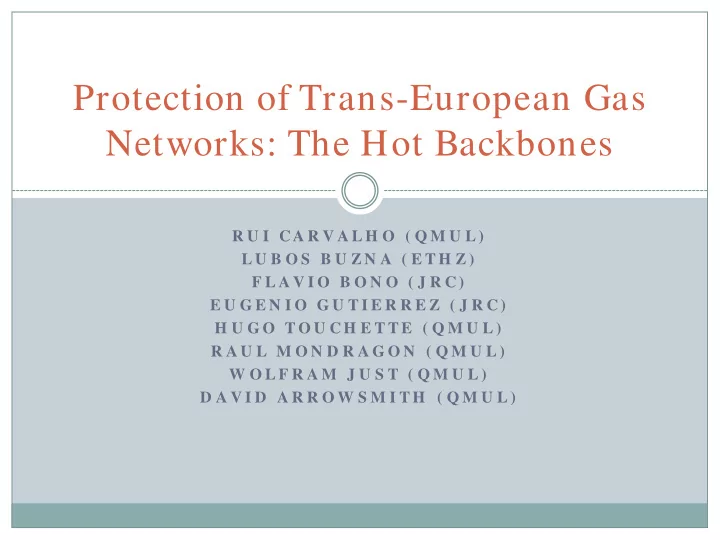

Protection of Trans-European Gas Networks: The Hot Backbones R U I CA R V A L H O ( Q M U L ) L U B O S B U Z N A ( E T H Z ) F L A V I O B O N O ( J R C) E U G E N I O G U T I E R R E Z ( J R C) H U G O T O U CH E T T E ( Q M U L ) R A U L M O N D R A G O N ( Q M U L ) W O L F R A M J U S T ( Q M U L ) D A V I D A R R O W S M I T H ( Q M U L )
QMUL: Current and Planned Collaborations NESA MASA LIUC QMUL JRC Catania ETHZ
Current Collaborations: EU consortia Lubos Buzna , Dirk Helbing (ETHZ)
Planned Collaborations (with H Touchette(QMUL) and L Buzna(ETHZ)): Roberta Sinatra, Vito Latora (Catania)
COST MP0 8 0 1 Workshop: Mod elling interd ep end ency b etw een Technolog ica l a nd Hum a n Sy stem s und er Crisis Scena rios ( ETH Zurich, June 8 -13, 20 0 9): http:/ / www.progettoreti.enea.it/ eventi/ Call_ for_ Papers_ rev1.htm
Activities for 2009 Carvalho, Buzna, Bono, Gutierrez and Arrowsmith, “Protection of Trans-European Gas Networks: The Hot Backbones” – draft available on the m anm ade server ; With Buzna (ETHZ), Touchette (QMUL), Sinatra (Catania) and Latora (Catania), “ A model for cascading failures on interdependent networks” – in progress; Modelling of the interdependencies which link social systems to large Critical Infrastructures (COST Action MP0801 workshop) –submit paper
Motivation Critical infrastructure networks seem to have evolved under pressure to minimize local rather than global failures; However, little is often known on how these local constrains condition the networks at a global scale. Open questions: Which quantities could help to unravel the global structure of CI networks? Is the protection of single nodes and links sufficient for the security of these networks? Should we, instead, identify the backbone which, if not secured, will bring the network down? Will the answer to these questions vary with the specific network under study and methodology followed or are there universal mechanisms at play in cross-continent infrastructure networks which would suggest unified protection approaches?
Datasets: the gas network Data provided by the JRC
Datasets: Gas Trade Network
Betweenness Centrality (Freeman 1977) Fraction of shortest paths between all possible pairs of nodes passing through a given edge e ( ) σ = ∑ e st C σ B s t , st ≠ s t 1 2 1 3 3 3 1 t s 3 1 2 k 1 3 3 3
Max Flow/ Min Cut Theorem Minim um Cut =4 Capacity 3 2 Sink 1 Source 3 1 1 3 1 3 1 2 1 4 3 2 2 1 1 1 2 4 2 4 http:/ / www-personal.umich.edu/ ~ladamic/
The Hot Backbones: Generalized Load Data provided by the JRC
The Hot Backbones: Max-flow Betweenness Vitality Data provided by the JRC
Discussion The Hot Backbones identify the backbones of the network where: Most weighted shortest paths are going through; Flow is lost if links are removed; These highlight the Achilles tendon of the network; Draft has a much more complete analysis which I did not discuss due to lack of time; Draft of paper available at the Manmade server, QMUL folder under ‘Drafts’ –please let us know what you think!
Recommend
More recommend